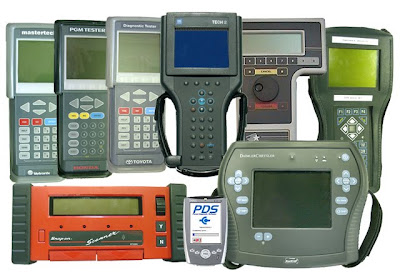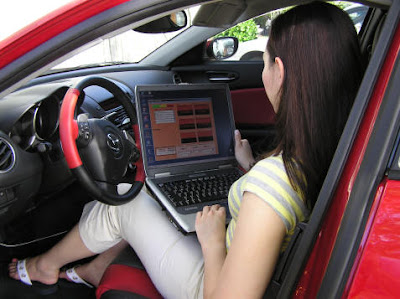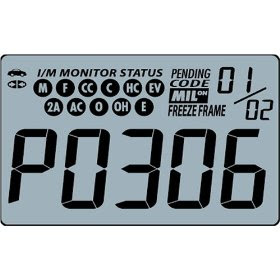
4825 ABS Brakes
Sunday, September 19, 2010
Tuesday, September 7, 2010
Scan Tools

 Using A Scan Tool
Using A Scan Tool ssue and repair it.
ssue and repair it.Monday, September 6, 2010
Scan Tool Observations
Which Vehicle Are you using? Land Rover
Which Scan Tool are you using? Auto Boss
2.2 What different functions are available on the scan tool to examine the CAN system?
Primary Ignition, secondary Ignition, Multimeter, DSO, Engine Analyser
2.3 List the different systems that are controlled by CAN? (note which are high speed and which are low speed)
High
ABS/ TCS/ Engine Control/ EPS
Low
Tv, Windows, Body Control
CAN Multiplexing worksheet
1.1 Locate the Range Rover or other suitable vehicle with easily accessible CAN system twisted wires. Which vehicle do you have? (Year, Make, Model)
2001 Landrover
1.2 Locate a twisted wire pair. Describe where the wires are located. The Twisted Wire Pair were located inside the engine bay on the Hydraulic Control Unit
1.3 Record the waveform of one of the wires below. ("make sure your time is small enough so you dont have aliasing")
Colour of wire: Yellow
Time per division: 2 Seconds
Voltage per division: 0.5V

1.4 Record the waveform of the other wire.
Colour of wire: Black
Time Per Division: 20ms
Voltage per division: 1V
1.5 What is aliasing? Describe it: When a digital image is viewed, a reconstruction-also known as an interpolation-is performed by a display, and by the eyes and the brain. If the resolution is too low, the reconstructed image will differ from the original image, and an alias is seen. Aliasing can be caused either by the sampling stage or the reconstruction stage; these may be distinguished by calling sampling aliasing prealiasing and reconstruction aliasing postaliasing
1.6 How do you know these waveforms are not alisaling?
Because they are symmetrical when placed together, and this is what it should like.
1.7 In the 1.3 Waveform above, what is the main voltage on the line? 2.5V
What is the other voltage on the line, when the voltage is pulled up or down to "talk"?
1.8 In the 1.4 Waveform above, what is the main voltage on the line? 1.5V
What is the voltage on the line, when the voltage is pulled up or down to "talk"?
1.9 Observe the signals in 1.3 and 1.4 with a voltmeter. Compare it with DC volts or AC volts setting . Which setting would tell you if the signal is switching. Explain. DC Would tell me if the signal is switching because I would get a straight line when it is either on, or off, while analogue will give me a curvy line.
Monday, August 23, 2010
On Car Exercises

Codes and diagnostics
Pick two transmission codes out of repair information, and describe what the code means and what mailfunction would cause the code:
Code: LR Solenoid Valve Open
Code:OD Solenoid Valve Open
Diagnosis:
For each code listed above, discuss what tests you could run to diagnose the problem.
1st problem testing:
With the vehicle stuck in 3rd gear, we tryed shifting the car into a different gear. But because all the solenoid valves were stuck open and wouldn't close, the vehicle would not shift and it stayed in 3rd gear.
2nd problem testing
For the 2nd test, we plugged the solenoid cable back into the transmission and turned the car on. We were then able to change up and down gears. We then used the scan tools to make sure the valves were closing when we changed gears and they did.
Shift Solenoids

Shift Solenoids
Which solenoids are "on" when this vehicle is shifted into drive and starts out in first gear?
Both Solenoids are on on when this vehicle is in 1st gear.
Which solenoids are "on" when this vehicle automatically shifts into second gear?
When the vehicle switches to second gear, the second solenoid is on
Which solenoids are "on" when this vehicle automatically shifts into third gear?
No solenoids are on when this vehicle is in 3rd gear
Which solenoids are "on" when this vehicle automatically shifts into fourth gear?
The 1st solenoid is on when this vehicle is in 4th gear
Shift solenoid mailfunction
Describe what would happen if none of these solenoids came "on". Could the vehicle drive? What gear would it be in? How fast could it go? Could it have the power to climb a hill?
If all the solenoids were off in this vehicle, the only gears this vehicle could use would be 3rd gear. That is because in 3rd gear this transmission does not need any solenoids on. The vehicle will be slow and sluggish at start off and could only use third gear. As for climbing a hill, the vehicle could drive up it if the vehicle had a running start.
